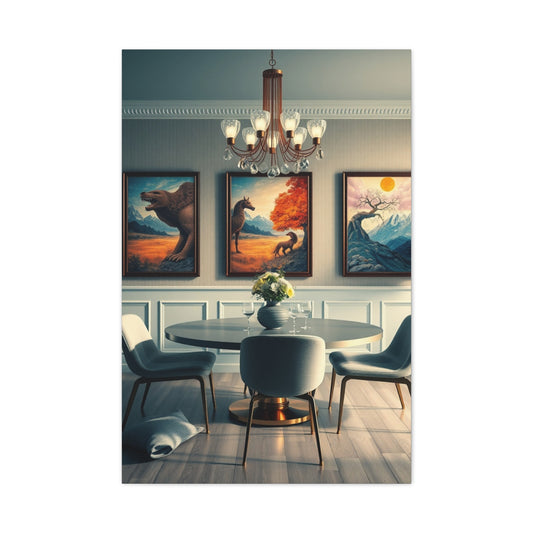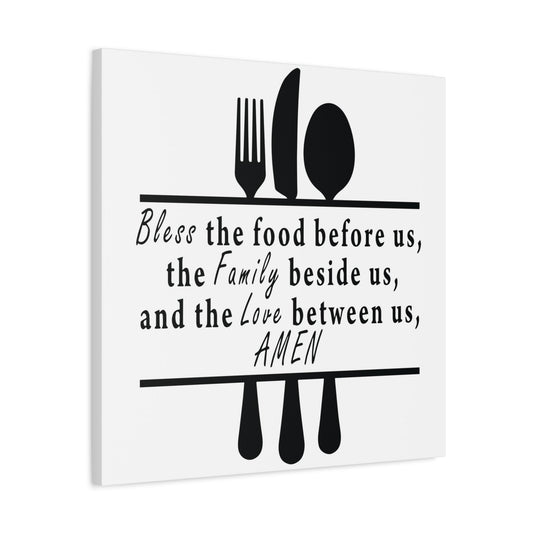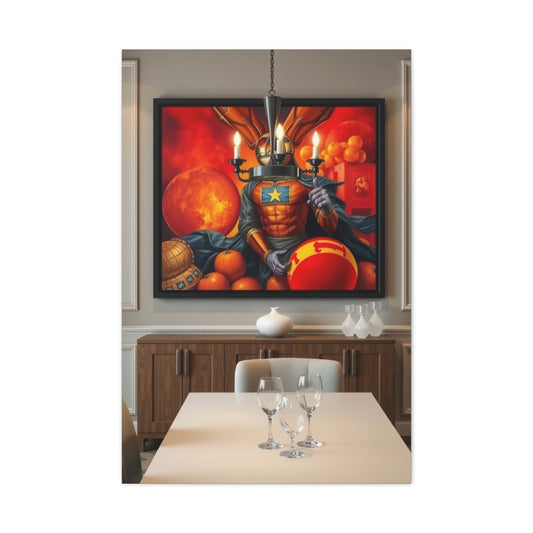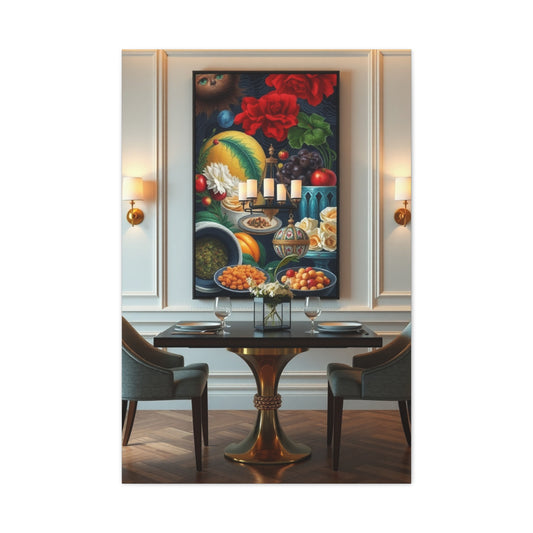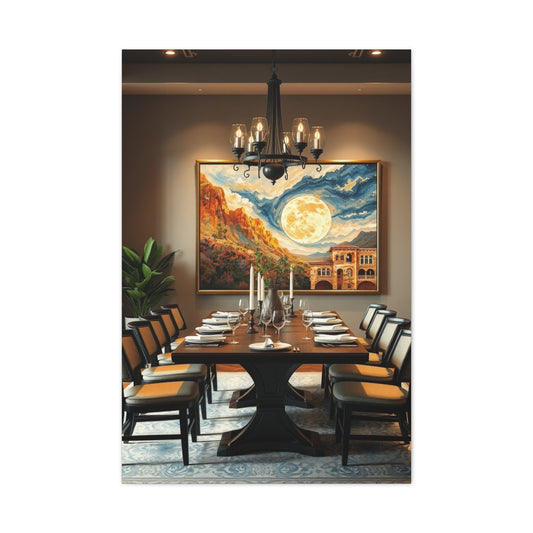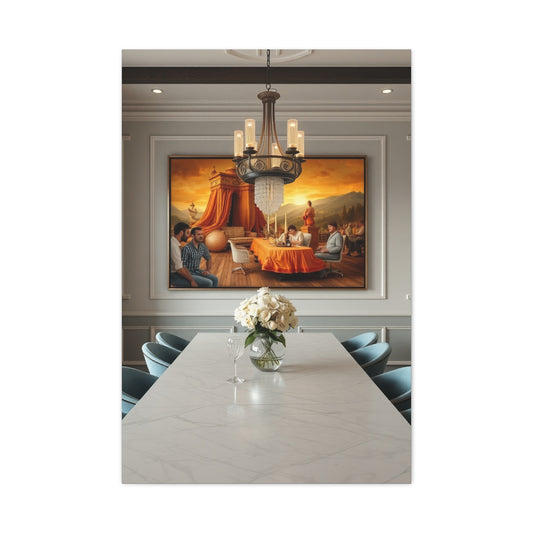Bid farewell to underwhelming mealtimes and usher in a new era of convivial gatherings. Whether you’re hosting summer soirées or impromptu dinner parties, the dining room is poised for a renaissance. It's time to infuse your dining space with renewed vitality and artistic sophistication. With just a single, eye-catching piece of Wall art, you can transform a once-neglected area into a lively hub of style and sociability.
If your dining room has been sidelined in recent years, there’s no better moment to rejuvenate it. This space, once reserved for formality, is now becoming a canvas for modern expression. As you prepare to welcome guests back into your home, investing in Wall art is a simple yet impactful way to cultivate ambiance, spark conversation, and establish a cohesive interior theme. With an expansive range of creative possibilities, we’ve curated this comprehensive guide to help you pinpoint the perfect piece and reinvigorate your dining space with flair and finesse.
Use the following sections to steer your dining room makeover in a direction that aligns with your taste and lifestyle:
Crafting a Contemporary Dining Experience
Today’s dining room décor transcends convention, emphasizing intimacy, airiness, and human connection. Inspired by Nordic principles like "Hygge," the aesthetic aims to cultivate comfort without excess. Think clean silhouettes, tactile textiles, and artwork that whispers serenity rather than shouts for attention. Instead of overloading your space with redundant embellishments, focus on strategic simplicity. A thoughtfully chosen Wall art piece can add just the right amount of visual intrigue without overshadowing the dining table’s primary role as a gathering place.
Opt for compositions that balance visual impact with subtle charm. Typography-based prints that deliver uplifting messages or phrases can act as gentle mood-setters. Pair these with neutral table settings and organic centerpieces for a cohesive, hygge-inspired haven. The goal is to encourage your guests to linger a little longer, soaking in both the flavors and the atmosphere.
|
Related Catagories: |
Infusing the Room with Sophisticated Minimalism
If you gravitate toward understated luxury, consider adopting a style that embodies restrained elegance. A dining room bathed in natural light and anchored by minimal Wall art exudes tranquility. Choose pieces that harmonize with the room’s foundational elements—light-toned wood, linen upholstery, and earthen ceramics. Abstract forms, monochromatic palettes, and geometric lines can add a touch of modernity without disrupting the room’s equilibrium.
This Scandinavian-influenced approach promotes a relaxed ambiance, perfect for fostering authentic interactions. Wall art in this setting acts as a visual exhale—clean, clear, and calming. Avoid anything too ornate; instead, celebrate the power of blank space and the poetry of minimal design.
Harmonizing Hues: Trending Color Combinations
Color has a profound impact on how we perceive a space, and current trends point toward nature-inspired palettes. Ground your dining area in earthy tones like ochre, sand, clay, and forest green. These hues mirror the serenity of the outdoors and offer timeless appeal. That said, don’t shy away from punctuating your palette with bursts of vibrant color.
If you’re seeking a cooler vibe, blue is a perennial favorite. Shades like muted slate, smoky indigo, and soft powder blue create a tranquil backdrop that’s especially striking when contrasted with warmer wood finishes. Pairing blue tones with creamy white, charcoal, or warm gray results in a balanced, contemporary tableau. Wall art featuring these shades can anchor the room visually while reinforcing a sense of peaceful refinement.
Draw inspiration from the ever-evolving landscape of interior design, which now embraces layered color schemes that blur the line between modernity and nostalgia. Curated Wall art that mirrors these palettes can serve as the unifying thread that brings your dining room together.
Designing a Contemporary Dining Room That Celebrates Connection
In recent years, the way we approach our living spaces has undergone a subtle yet profound metamorphosis. No longer confined to formal dinners or rare occasions, the dining room has taken on a more dynamic and intimate role in the modern home. It has transformed into a multi-functional enclave—a space not just for nourishment, but for conversation, collaboration, and repose. As our daily lives grow more hectic, the dining area emerges as a much-needed anchor, inviting us to pause, reconnect, and savor the moment.
Contemporary design now leans into authenticity and comfort. Drawing inspiration from the Scandinavian concept of Hygge, which celebrates warmth, togetherness, and understated elegance, the new-age dining space thrives on tactile materials, subdued lighting, and elements that encourage lingering and laughter. It's no longer about high polish or rigid formality, but rather a return to the elemental—a space where every object contributes to emotional well-being.
A Palette of Serenity and Simplicity
At the heart of this transformation is a color palette grounded in tranquility. Think of hues reminiscent of fog-laden mornings and sun-bleached timber: soft taupes, misty greys, creamy ivories, and muted pastels. These tones not only soothe the senses but also amplify natural light, creating a serene and enveloping environment.
Minimalist doesn't mean sterile, however. To ensure the space doesn’t feel stark, layering is key. Introduce depth through organic textures—linen table runners, woven placemats, matte ceramics, and warm wood finishes. These tactile elements harmonize the visual experience and invite interaction with the space. The goal is to curate an atmosphere that is both uncomplicated and profoundly personal.
Furniture That Fosters Togetherness
When it comes to selecting dining furniture, focus on pieces that encourage intimacy and dialogue. A round or oval table, for example, eliminates sharp boundaries and ensures everyone remains part of the conversation. Choose chairs with ergonomics in mind—ones that provide comfort for extended meals and spontaneous storytelling.
Materials play a significant role here. Opt for reclaimed wood, brushed metal, or rattan for an aesthetic that blends rusticity with modern poise. Even the smallest details—like hand-carved chair legs or a subtly imperfect wood grain—can add a layer of character that feels intentional rather than curated.
Illuminating the Mood
Lighting is the unsung hero of any dining room. To evoke a contemporary yet inviting atmosphere, consider pendant lights with sculptural silhouettes, or go for an understated chandelier that casts a soft, diffused glow. Adjustable fixtures or dimmable lighting systems allow you to tailor the ambiance, whether you're hosting a spirited gathering or enjoying a quiet dinner for two.
Candles remain a quintessential part of the Hygge vocabulary. Cluster a few along the table or on a nearby shelf to create a flickering warmth that enhances the room's intimacy and charm.
Elevating the Space with Wall Art
No modern dining room is complete without the magnetic allure of Wall art. This element ties the visual story together, adding a personalized focal point that elevates the ambiance from utilitarian to unforgettable. For a Hygge-inspired aesthetic, consider artworks that communicate calm and clarity—think abstract landscapes, soft watercolors, or monochromatic sketches.
If you're looking to make a statement without overwhelming the room's subtle decor, typographic artwork is a striking solution. A poignant phrase, cherished quote, or single word rendered in bold, elegant font can imbue the space with both visual rhythm and emotional gravitas. It's a simple addition, yet it offers rich narrative potential. Pair this with minimalist framing to maintain the room’s modern equilibrium.
Gallery-style arrangements also work beautifully in dining areas, especially when curated with thematic cohesion. Consider a triptych of organic motifs or a mix of framed prints and hand-drawn elements for an engaging, layered aesthetic.
The Power of Functional Accessories
Beyond aesthetics, functionality plays an integral role in modern dining design. Use accessories that serve both decorative and practical purposes—ceramic pitchers that double as vases, handcrafted bowls that anchor centerpieces, or artisanal trays that can hold fruit by day and candles by night.
Greenery also deserves a place at the table—literally and metaphorically. Incorporating houseplants or fresh cuttings adds life and vitality to the room, acting as a quiet nod to the natural world. Choose low-maintenance plants like eucalyptus, pothos, or dried wildflowers, which complement the organic textures and tones of a Hygge-inspired dining setup.
Infusing Your Personality Through Details
Every well-curated space tells a story. Allow your dining area to become a reflection of your own narrative—one made up of textures, memories, and subtle symbolism. Perhaps that’s a vintage wall clock that once belonged to your grandmother or a hand-thrown ceramic bowl picked up during a seaside holiday.
You don’t need to overcrowd the space with mementos, but a few thoughtfully placed personal elements lend soul to the structure. These sentimental inclusions offer not just aesthetic value, but emotional resonance—ensuring your dining room isn’t just stylish, but deeply meaningful.
Final Touch: A Sensory Invitation
Dining is an inherently sensory experience. Heighten this connection by attending to sound, scent, and touch. A soft playlist humming in the background, the aroma of fresh herbs or baked bread, a warm wool throw draped over a bench—each detail deepens the sense of welcome.
When thoughtfully composed, your dining room becomes more than a place to eat. It transforms into a stage for shared experiences, a backdrop for laughter, and a container for cherished memories.
Cultivate Tranquility in Your Dining Room with Artful Minimalism
In a world of ever-escalating visual noise and decorative excess, the elegance of restraint is having a renaissance. Nowhere is this clearer than in modern dining rooms, where sleek simplicity and subtle intentionality have become the gold standard. At the heart of this shift lies the powerful use of minimalist Wall art—pieces that speak softly but carry immense atmospheric weight.
Minimalist décor is not about creating a sterile or impersonal space. On the contrary, it's about distilling a room down to its most essential, most expressive elements. The dining room, often a hub for communal connection and intimate conversation, benefits immensely from this pared-back philosophy. When done right, it becomes an oasis of calm, sophistication, and character.
The Art of Understatement: Making Space for Meaning
A truly refined dining space begins not with what you add, but with what you intentionally leave out. Minimalist Wall art plays an integral role here, acting not as an overwhelming statement but as an anchoring presence that brings cohesion to the room. Think of it as the visual pause that allows the rest of your dining environment to breathe.
Look for artwork that incorporates gentle hues—muted grays, warm whites, and soft sepia tones can lend an ethereal quality to your walls. These shades invite a sense of openness while avoiding distraction. Organic forms, delicate brushwork, and abstract compositions are all ideal choices for evoking contemplative moods without overpowering the senses.
Nordic Nuance: A Scandinavian Foundation
Scandinavian design has long been synonymous with understated elegance, and its principles are a natural fit for minimalist dining room aesthetics. Rooted in functionality, comfort, and natural beauty, this approach champions a harmonious blend of texture and tone.
Incorporate elements like light-toned hardwood flooring, woven textiles, and sculptural lighting to build a neutral canvas. Upon that, layer your chosen piece of Wall art. Whether it’s a charcoal sketch, a subdued line drawing, or a monochrome canvas, the art should echo the serenity of the materials around it.
What distinguishes Scandinavian minimalism from colder iterations of the style is its warmth. It is not minimalism for austerity’s sake—it is minimalism that invites coziness and ease, a kind of hygge for the eyes.
Central Art as the Visual Hearth
Even the most stripped-down dining room needs a point of visual convergence. A central Wall art piece can function as the heart of the space, offering a moment of visual poetry around which the rest of the room orbits.
Choose a work that offers subtle intricacy—perhaps a quiet geometric composition or a canvas imbued with texture rather than vibrant pigment. This focal point need not be loud to be effective; its power lies in its stillness, in how it draws the eye without clamoring for attention.
Position it above a sideboard or at the head of the table to create spatial balance. Let it sit at eye level, where its details can be appreciated as guests linger over shared meals and meaningful conversation.
Embracing Natural Palettes and Organic Form
To fully embrace minimalist refinement, connect your space to nature through both color and form. Neutral, earth-derived hues—think sandstone, sage, driftwood, and bone—cultivate a timeless elegance. These tones bring visual lightness to the dining room and provide a calming backdrop for gatherings.
Pair your Wall art with natural materials to amplify the organic ambience. Linen table runners, ceramic dishware with hand-glazed finishes, and touches of greenery can all coexist beautifully alongside minimalist artwork. Together, they create a dining room that feels less like a set piece and more like a living, breathing part of your home.
Infusing Personality into Clean Design
The beauty of minimalist interior design is that it creates space for subtle personal storytelling. Your Wall art doesn’t need to scream to be heard. Even within a tightly edited space, there’s room for whimsy, emotion, and personal flair.
Handpicked art prints, hand-stitched textiles, or a single handcrafted sculpture can infuse your room with individuality. This is the charm of modern minimalism—it doesn’t erase personality; it amplifies it by stripping away the superfluous.
A splash of ochre in an otherwise grayscale canvas, or a single accent wall in a subdued olive tone, can add just enough surprise to keep your minimalist room from feeling too uniform. The key is moderation. Small, intentional choices echo louder in a quiet room.
Curated Accessories as Conversation Enhancers
Minimalism does not preclude detail—it simply elevates it. Every object in a minimalist dining room is chosen with intent, which means accessories must be curated with both aesthetic and emotional resonance in mind.
Consider pairing your Wall art with accessories that enhance its narrative. A trio of textured vases beneath an abstract painting, a single sculptural light fixture that mimics the curves in your artwork, or even a table centerpiece that picks up on the hues in your canvas—these touches transform a minimalist room into an immersive visual experience.
Less clutter invites more focus, allowing these small details to become impactful rather than lost in visual cacophony.
A Room for Repose and Reflection
Beyond its decorative appeal, a minimalist dining room offers something rare: mental clarity. By reducing visual noise and centering your design around a thoughtful piece of Wall art, you invite guests to slow down. The room becomes less about stimulation and more about presence.
This is particularly vital in the dining area, where shared meals can be one of life’s most grounding rituals. A serene space encourages longer meals, deeper conversations, and an overall sense of being anchored in the moment.
Seasonal Shifts with Minimal Adjustments
Minimalist dining rooms are exceptionally adaptable. You don’t need a full redecoration to reflect seasonal moods—simply rotating your artwork or updating accessories can refresh the entire space.
In the colder months, you might introduce pieces with heavier textures or deeper tones—perhaps a charcoal ink print or a warm-toned wood frame. During spring and summer, opt for airier compositions with lighter palettes to evoke renewal and brightness.
This gentle evolution keeps your space dynamic without undermining its core simplicity.
Discover the Art of Dining Room Ambience Through Modern Color Mastery
The dining room is no longer a purely functional space—it's a realm of social connection, culinary celebration, and aesthetic expression. Designing this area with intentionality demands more than furniture arrangement; it requires a nuanced understanding of color psychology and visual cohesion. As 2025 interior trends lean toward grounded elegance with a modern twist, color palettes drawn from nature are leading the charge. By integrating nature-inspired hues with curated Wall art, your dining space can become a sanctuary of warmth, style, and sophistication.
Nature as Muse: The Return of Organic Hues
The earth remains an ever-reliable muse when selecting a palette that is both contemporary and enduring. Subdued neutrals—think sandstone, warm clay, oatmeal, and driftwood—form the perfect backdrop for layering complexity and vibrancy. In 2025, these grounded tones are being revitalized with flashes of living color. Picture the saturated green of springtime foliage, the moody blue of a twilight sky, or the muted terracotta of desert rock. These subtle yet evocative shades breathe life into a room, transforming it from static to spirited.
By choosing pigments inspired by the elements—air, earth, water, and flora—you root your dining room in timeless elegance while also opening the door to seasonal adaptability. This organic palette creates a serene canvas that invites meaningful experiences, whether it’s a sunlit brunch or an ambient evening gathering.
The Rise of Blue as a Foundational Hue
While beige, ivory, and taupe continue to hold sway in modern interiors, 2025 sees a compelling shift: blue is emerging as a foundational color, transcending its traditional role as an accent. Especially in its muted forms—powder blue, stormy slate, or silvery indigo—blue offers a sense of tranquility without sacrificing depth.
These cooler tones establish a serene, almost contemplative mood, ideal for spaces where conversation and connection unfold. Paired with warm wooden textures and ivory textiles, blue creates a captivating equilibrium between coolness and coziness. Whether painted on the walls or echoed in ceramics and upholstery, this reinvented neutral creates an ambiance that is current, comfortable, and exquisitely composed.
Cool Meets Warm: Blending Temperature with Texture
One of the subtler design principles gaining momentum is the harmony of warm and cool tones. This isn't merely about contrast—it’s about creating a layered visual environment that mirrors the diversity of the natural world. When slate blue is paired with honey-toned wood, or when misty grey meets wheat-colored linen, the result is a dining space that feels lived-in and intentional.
Textures play a pivotal role in this alchemy. Matte finishes, brushed metals, and natural fibers like jute or linen can soften bolder hues while enriching more understated ones. Incorporate handcrafted Wall art that mirrors this philosophy—textural compositions, botanical sketches, or abstract landscapes can seamlessly elevate the tonal narrative while reinforcing your room’s personality.
Harmonizing Hues: Building a Modern Dining Palette
Curating a modern palette isn't about choosing colors at random; it’s a dance of balance and subtle storytelling. A timeless yet avant-garde combination to explore includes ash grey, gentle mustard, sage green, and obsidian black. These muted, complex colors resonate with understated luxury and versatility. They marry well with oak, walnut, and even painted finishes, allowing you to craft a personalized space with enduring style.
Sage green introduces a hint of the botanical without overwhelming, while soft yellow provides just enough brightness to lift the room. Grey grounds the space in neutrality, and deep black infuses depth and modernity. When arranged in careful tandem, these shades offer an adaptable foundation for evolving tastes.
Complement these colors with intentional accents—linen table runners, sculptural lighting, and atmospheric Wall art that encapsulates the ethos of this refined aesthetic. Choose pieces that echo your color choices but introduce layered narratives or visual intrigue, creating focal points without visual chaos.
The Impact of Wall Décor on Color Flow
Color choice doesn't live in isolation—it interacts intimately with furniture, flooring, and, crucially, wall design. In many cases, Wall art acts as the visual anchor of a dining space, offering cohesion and narrative that ties the room together. A monochromatic piece with layered blues can reinforce a tranquil color scheme, while abstract works with mustard and green accents might invigorate the space with subdued dynamism.
|
Related Catagories: |
Curated collections of Wall art can also serve as an entry point for those feeling uncertain about color. They demonstrate how hues work together in practice, and offer an easy way to introduce complexity through composition, texture, and tone. You might opt for a singular statement canvas above a dining console or a gallery wall that shifts with the seasons. In either case, your walls become part of the color experience—alive, evolving, and exquisitely tailored.
Designing for Experience, Not Just Aesthetics
While color can undeniably transform a space visually, its impact extends far beyond what meets the eye. Hues influence mood, encourage interaction, and even affect appetite. Cool tones like blue and grey are known to foster calm and focus, making them ideal for slow, thoughtful meals. Warm accents such as ochre and amber can create a more inviting, convivial atmosphere, ideal for festive dining or family gatherings.
Understanding this psychology allows you to craft an environment not just for looking, but for living. Your dining room becomes a multi-sensory tableau—where the colors on the walls echo the laughter around the table, and where textures tell the story of intentional living.
Curating the Perfect Scale: Choosing the Ideal Wall Art for Your Dining Room
When adorning your dining room with Wall art, scale isn't just an aesthetic consideration—it's an imperative. The proportionality of your artwork influences not only visual harmony but also how the entire room feels. A piece that's too diminutive may get swallowed by expansive walls, while an overly large canvas can overwhelm a modest space, throwing off the delicate spatial equilibrium that defines an inviting dining experience.
Choosing the right dimensions for your Wall art involves more than matching size to space; it's about crafting a composition that feels intuitive and engaging. From commanding single-panel centerpieces to modular multi-panel arrangements, each choice contributes its own unique rhythm to the overall ambiance of your dining room.
Understanding Spatial Synergy Between Furniture and Art
The dining table, often the gravitational center of the room, plays a pivotal role in determining art scale. Ideally, your Wall art should span between two-thirds to three-quarters of the table’s width. This rule of thumb ensures visual continuity, anchoring the wall décor in relation to the furniture below it.
Imagine a rustic walnut table flanked by linen-covered chairs—above it, a panoramic abstract Wall art piece in soothing neutrals extends gracefully without encroaching upon the side edges. This arrangement draws the eye horizontally and subtly emphasizes the gathering space.
Verticality is another critical dimension. The ideal hanging height positions the artwork’s center at eye level, typically around 57 to 60 inches from the floor. In dining rooms, where guests are mostly seated, slightly lowering this midpoint can foster a more intimate viewing angle and enhance the sensory connection with the artwork.
Statement Pieces: Oversized Artworks for Maximum Impact
In expansive or high-ceilinged dining rooms, oversized Wall art can be an anchor of visual drama. These commanding canvases infuse character into large blank walls, introducing a sense of scale that smaller frames simply can’t replicate.
Picture a dramatic ink-splashed canvas, five feet wide, suspended behind a minimalist dining set—its boldness becomes the room’s focal crescendo. Alternatively, a landscape-oriented painting in moody blue-gray gradients can amplify the feeling of spaciousness, especially when paired with streamlined furniture in complementary hues.
Oversized art is best utilized when there’s breathing space around it. Avoid crowding it with too many adjacent pieces or ornamental elements, as the grandeur of scale deserves a stage of its own.
The Allure of Multi-Panel Arrangements
For those who crave movement and modularity, multi-panel Wall art delivers a rhythmic alternative to singular works. Triptychs, quadriptychs, and even staggered grid patterns introduce repetition and layered energy into the room.
The beauty of these arrangements lies in their ability to follow the natural lines of the dining room. Panels spaced evenly across a central axis can mirror the symmetry of a chandelier or dining bench, while an offset vertical stack can add playful asymmetry in more eclectic settings.
Themes for multi-panel artwork range from synchronized botanical prints to abstract ink blotches rendered across consecutive canvases. Choose designs that speak to your dining room’s atmosphere—be it serene and nature-inspired or modern and edgy.
Small Spaces, Big Style: Art for Compact Dining Areas
In cozier homes or apartments, scale becomes even more nuanced. Small dining rooms can still bask in the glow of artful storytelling, provided proportions are handled delicately. Here, gallery walls or curated clusters of small to medium-sized Wall art work wonderfully.
Select pieces of varied dimensions but unified by palette or framing style. A collage of soft-toned watercolor sketches or minimalist line drawings can evoke sophistication without overwhelming the walls. Round or oval frames add a fluid contrast to angular furniture, creating visual softness.
In narrow nooks or galley-style dining rooms, vertical artworks can elongate the perception of height. Longline illustrations or portraits framed in antique gold or brushed silver help elevate the space—both literally and atmospherically.
Choosing Artwork That Reflects Dining Room Aesthetics
Scale and placement are foundational, but the soul of the space lies in the art’s content. Dining rooms thrive on atmosphere—often convivial, sometimes romantic, and always deeply sensory. Choose Wall art that reflects and enhances this ethos.
Nature-inspired motifs such as botanical close-ups, vineyard vistas, or stylized fruit still-lifes connect organically with the culinary spirit of the room. Abstract art offers more interpretive experiences, inviting guests to derive their own meanings and emotional responses over a shared meal.
For a more avant-garde flair, consider experimental media—textured acrylics, hand-torn paper collages, or mixed-media works that incorporate materials like silk or jute. These rarefied additions can elevate even the simplest dining arrangements into curated gallery-like experiences.
Materials, Frames, and Texture: Enhancing Dimensional Impact
When selecting your Wall art, factor in not only the size but also the physicality of the piece. Materials and framing play pivotal roles in how the artwork interacts with light and space.
A canvas print with a matte finish offers a different feel than one rendered in high-gloss acrylic. Wood-framed paintings exude warmth and tactility, while metal frames suggest modernity and edge. Textured art—especially those with three-dimensional layering—can provide visual intrigue even from afar, drawing the viewer closer for exploration.
This tactile dimension is especially impactful in dining rooms where the atmosphere is experienced up close. Think sculptural wall hangings, woven tapestries with metallic accents, or deeply embossed prints that change appearance as the lighting shifts through the day.
Lighting Considerations for Optimal Presentation
Once you’ve chosen the right scale and composition, lighting becomes the unsung hero of your Wall art’s presentation. Inadequate illumination can flatten even the most vibrant piece, while strategic lighting can imbue it with brilliance and dynamism.
Consider wall-mounted picture lights for classic artwork, or use adjustable ceiling spotlights for larger or multi-panel displays. Soft LED strips placed subtly above or below the piece can add an ambient glow, especially effective for textured or dimensional art.
Natural light is an ally but must be managed to prevent UV damage. If your dining room receives copious sunlight, opt for UV-resistant glass or consider hanging your artwork in a less exposed spot.
Go-To Dimensions for Maximum Impact
A reliable rule of thumb? A 52"x32" canvas fits beautifully above most dining setups. It’s large enough to command attention without overpowering the room. You can also explore staggered layouts with multiple canvases for an art gallery-inspired aesthetic.
Shape and Layout: Tailoring the Visual Flow
Once you’ve chosen your colors and size, consider shape and layout. Each configuration conveys a different stylistic tone:
-
The single-canvas layout exudes timeless simplicity
-
Dual panels offer visual symmetry with a modern edge
-
Multi-panel sets (three to five pieces) bring depth and dynamism
-
Hexagonal canvases are perfect for those who love a daring, geometric twist
Choose a layout that aligns with your interior goals—whether that’s harmony, contrast, or bold innovation.
Explore More Dining Room Design Inspiration
Hungry for more design guidance? Explore in-depth resources on trending Wall art styles and décor techniques tailored to hosting. From dinner party aesthetics to complete home transformation guides, there’s an endless buffet of inspiration waiting for you.
Modernizing your dining room doesn’t require structural changes—just a few intentional adjustments. With the right Wall art, your dining area can transform from underutilized to unforgettable. Whether you favor minimalist elegance or vibrant storytelling, let your artwork speak volumes and set the mood for memorable meals and meaningful connections.
Final Thoughts: Redefine Dining with Wall Art
Your dining room is more than a utilitarian space—it’s the setting for everyday rituals, milestone celebrations, and everything in between. Elevating this area with expressive Wall art can breathe life into even the most unassuming corners. Whether your taste leans toward minimalist elegance or eclectic grandeur, there’s a piece of art that can encapsulate your vision and enhance your atmosphere.
As the season for socializing dawns once again, embrace the opportunity to redefine your dining space. Let it reflect not only current design trends but your own personality and panache. With the right Wall art guiding your design direction, your dining room will no longer be an afterthought—it will be the heart of your home.
In designing a contemporary dining room that celebrates human connection, you’re creating more than just a stylish interior—you’re crafting an experience. One that embraces comfort over ceremony, intimacy over spectacle. With tactile materials, thoughtful lighting, and expressive Wall art, your dining space becomes a living narrative—one where aesthetics and emotion intersect beautifully.
Through the quiet power of art, natural textures, and curated balance, your dining space becomes a canvas for serenity and connection. Strip away the excess, embrace the essence, and allow your personality to emerge with grace. After all, it’s in the subtle strokes that the most profound stories are told.
Selecting the right size of Wall art for your dining room is both a science and an art—a study in proportion, presence, and poise. Beyond aesthetics, it’s about emotional resonance. The correct scale not only amplifies the beauty of your interior but also enriches the shared experience of dining, laughter, and conversation.
By thoughtfully considering the spatial relationship between your furniture and artwork, exploring formats from grand-scale canvases to intricate gallery clusters, and aligning the artwork’s essence with your room’s mood, you invite depth and dimension into your dining space. Let your Wall art become a silent host—charming, expressive, and unforgettable. When chosen with care and calibrated in size, it transforms mealtime from a daily ritual into an elevated experience of visual and sensory delight.












